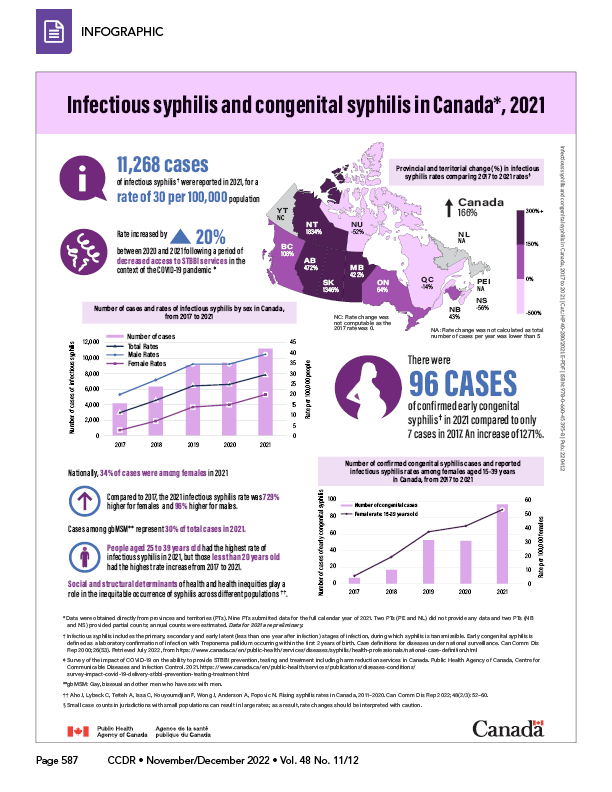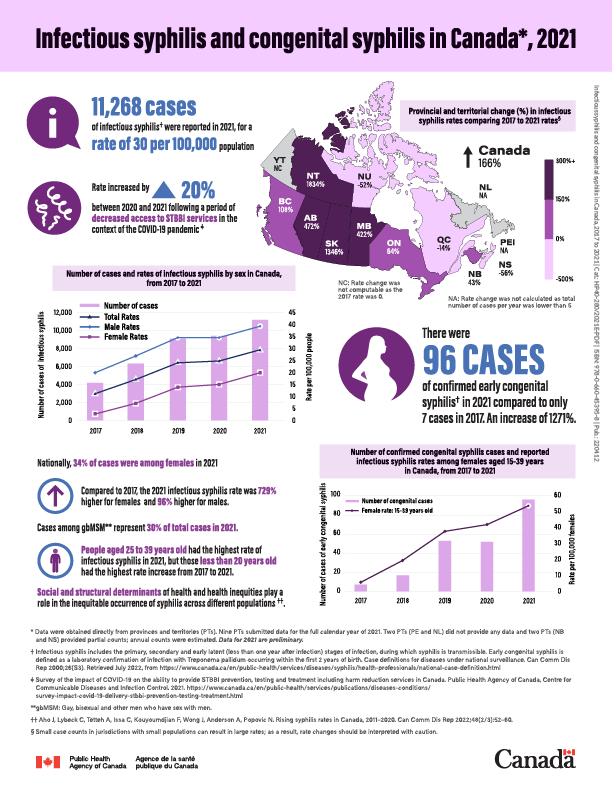Infectious syphilis and congenital syphilis in Canada, 2021

 Download this article as a PDF
Download this article as a PDFPublished by: The Public Health Agency of Canada
Issue: Volume 48-11/12, November/December 2022: Antimicrobial Use and Stewardship
Date published: November/December 2022
ISSN: 1481-8531
Submit a manuscript
About CCDR
Browse
Volume 48-11/12, November/December 2022: Antimicrobial Use and Stewardship
Infographic
Infectious syphilis and congenital syphilis in Canada, 2021

Text description: Infographic
- In 2021, there were 11,268 cases of infectious syphilis Footnote † reported nationallyFootnote *, for a rate of 30 cases per 100,000 people. The 2021 national infectious syphilis rate was 166% higher than the 2017 rate.
- From 2017 to 2019, the national rate of infectious syphilis increased by 116%.
- From 2019 to 2020, however, rates of infectious syphilis remained relatively stable (increased by 2%). This may be partially explained by a decreased demand for and ability to deliver sexually transmitted blood borne infections services during the beginning of the COVID-19 pandemicFootnote ‡.
- From 2020 to 2021, the national rate of infectious syphilis increased by 20%.
| Year | Number of infectious syphilis cases | Rate per 100,000 males | Rate per 100,000 females | Total rate per 100,000 people |
|---|---|---|---|---|
| 2017 | 4,132 | 20.2 | 2.4 | 11.3 |
| 2018 | 6,371 | 27.3 | 7.0 | 17.2 |
| 2019 | 9,181 | 35.0 | 13.8 | 24.4 |
| 2020 | 9,498 | 34.7 | 15.1 | 25.0 |
| 2021 | 11,268 | 39.7 | 20.2 | 30.0 |
Infectious syphilis by sex and sexual orientation:
- Among females, the 2021 national infectious syphilis rate was 729% higher than the 2017 rate.
- Among males, the 2021 national infectious syphilis rate was 96% higher than the 2017 rate.
- Nationally, 1 in 3 cases (34%) were among females in 2021, compared to 11% in 2017.
- In 2021, six provinces and territories provided sexual orientation data: British Columbia (BC), Alberta (AB), Saskatchewan (SK), Ontario (ON), New Brunswick (NB), and the Yukon Territories (YT). These provinces and territories represented 69% of the Canadian population and 79% of infectious syphilis cases. According to their data, gbMSMFootnote ** cases represented 30% of all reported syphilis cases in 2021.
Infectious syphilis by age group:
- The 25 to 39 years age group had the highest rate of infectious syphilis in 2021, but the highest observed increase in rate from 2017 to 2021, was in those less than 20 years old.
| Age group | Infectious syphilis rate per 100,000 people in 2017 | Infectious syphilis rate per 100,000 people in 2021 | Percent rate change from 2017–2021 (%) |
|---|---|---|---|
| <15 years | 0.1 | 0.4 | ↑ 698% |
| 15–19 years | 5.6 | 25.6 | ↑ 357% |
| 20–24 years | 20.2 | 65.2 | ↑ 222% |
| 25–29 years | 27.0 | 79.4 | ↑ 194% |
| 30–39 years | 24.8 | 71.5 | ↑ 188% |
| 40–59 years | 13.8 | 29.3 | ↑ 112% |
| >60 years | 2.5 | 4.5 | ↑ 81% |
Social and structural determinants of health and health inequities play a role in the inequitable occurrence of syphilis across different populationsFootnote ††.
Change in rates of reported cases of infectious syphilis comparing 2017 to 2021 rates by province and territory
| Province or territory | Infectious syphilis rate per 100,000 people in 2017 | Infectious syphilis rate per 100,000 people in 2021 | Percent change in infectious syphilis rates from 2017–2021 (%) |
|---|---|---|---|
| BC | 10.3 | 21.5 | ↑ 108% |
| AB | 12.6 | 72.2 | ↑ 472% |
| SK | 10.4 | 150.9 | ↑ 1,346% |
| MB | 18.8 | 98.1 | ↑ 422% |
| ON | 11.5 | 18.9 | ↑ 64% |
| QC | 11.0 | 9.4 | ↓ -14% |
| NB | 2.5 | 3.5 | ↑ 43% |
| NS | 2.7 | 1.2 | ↓ -56% |
| NL | 7.4 | NAFootnote a | NAFootnote a |
| PE | 2.7 | NAFootnote a | NAFootnote a |
| YT | 0 | 16.3 | NCFootnote b |
| NT | 11.1 | 215.4 | ↑ 1,834% |
| NU | 234.4 | 111.7 | ↓ -52% |
| Canada | 11.3 | 30.0 | ↑ 166% |
- Provinces and territories that had a change in rates of infectious syphilis above the national rate change of 166% included:
- Northwest Territories (1,834%)
- Saskatchewan (1,346%)
- Alberta (472%)
- Manitoba (422%)
- Provinces and territories that had a change in rates of infectious syphilis below the national rate change of 166% included:
- British Columbia (108%)
- Ontario (64%)
- New Brunswick (43%)
- Québec (a decrease of 14%)
- Nunavut (a decrease of 52%)
- Nova Scotia (a decrease of 56%)
Congenital syphilis
| Year | Number of confirmed early congenital syphilis cases | Female rate (15–39 years old) per 100,000 females |
|---|---|---|
| 2017 | 7 | 6.2 |
| 2018 | 17 | 19.4 |
| 2019 | 53 | 38.0 |
| 2020 | 52 | 41.6 |
| 2021 | 96 | 53.8 |
- There were 96 cases of confirmed early congenital syphilis in 2021.
- From 2017 to 2019, the number of cases of early congenital syphilis increased 657%.
- From 2019 to 2020, the number of cases of early congenital syphilis remained relatively stable.
- From 2020 to 2021, the number of cases of early congenital syphilis increased 85%.
- The number of cases of early congenital syphilis has increased in parallel to the observed increases in rates of infectious syphilis in females aged 15 to 39 years.
- From 2017 to 2021, rates of infectious syphilis among females aged 15 to 39 years increased annually.
- The 2021 national infectious syphilis rate among females aged 15 to 39 years is 768% higher than the 2017 rate, and the 2021 national number of cases of early congenital syphilis is 1271% higher than in 2017. Rates rose the fastest from 2017 to 2019.
© Her Majesty the Queen in Right of Canada, as represented by the Minister of Health, 2022 | Cat.: HP40-280/2021E-PDF | ISBN: 978-0-660-45395-8| Pub.: 220412
- Footnote †
-
Infectious syphilis includes the primary, secondary and early latent (less than one year after infection) stages of infection, during which syphilis is transmissible. Early congenital syphilis is defined as a laboratory confirmation of infection by Treponema pallidum occurring within the first 2 years of birth. Case definitions for diseases under national surveillance. Can Comm Dis Rep 2000;26(S3). Retrieved July 2022, from http://www.phac-aspc.gc.ca/publicat/ccdr-rmtc/00vol26/26s3/index.html
- Footnote *
-
Data were obtained directly from provinces and territories (PTs). Nine PTs submitted data for the full calendar year of 2021, two PTs (PE and NL) did not provide any data and two PTs (NB and NS) provided partial counts; annual counts were estimated. Data for 2021 is preliminary.
- Footnote ‡
-
Survey of the impact of COVID-19 on the ability to provide STBBI prevention, testing and treatment including harm reduction services in Canada. Public Health Agency of Canada, Centre for Communicable Diseases and Infection Control. 2021. Retrieved July 2022, from https://www.canada.ca/en/public-health/services/publications/diseases-conditions/survey-impact-covid-19-delivery-stbbi-prevention-testing-treatment.html
- Footnote **
-
gbMSM: Gay, bisexual and other men who have sex with men.
- Footnote ††
-
Aho J, Lybeck C, Tetteh A, Issa C, Kouyoumdjian F, Wong J, Anderson A, Popovic N. Rising syphilis rates in Canada, 2011–2020. Can Comm Dis Rep 2022;48(2/3):52–60.
